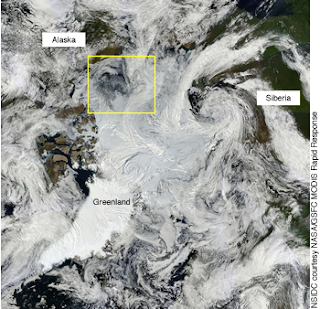Researchers at the Toolik Field Station study thermokarst to understand the ecological effects of climate change
- By Christine Dell’Amore
- Smithsonian.com, July 22, 2008
Read more:
Knee-deep in the muddy shambles of collapsed Alaskan tundra, Elissa Schuett points to the remains of a cavern that she was able stand in last summer. Today, it is gone, gobbled up by the gaping maw known as a a thermokarst that continues to march outward as the land rapidly melts.
Thermokarst failures occur when permafrost—a layer of frozen soil in Earth's polar regions—thaws and becomes unstable. Though the events occur naturally throughout the Arctic , many scientists suspect that rising temperatures in the north are causing more of these features to form. By comparing aerial photographs from 1985 with recent photos, "We can now say with some assurance... that in some locations [there are] between two and five times more of these features now than in the early 1980s," says William Bowden, an aquatic ecologist at the University of Vermont
That's why Bowden, his research assistant Schuett, and others at Toolik Field Station, a University of Alaska, Fairbanks, research facility 150 miles north of the Arctic Circle in northern Alaska, are studying the impact of thermokarsts on the environment. Their work fits into a long tradition of climate change research at Toolik, which, since its founding in 1975, has provided a pristine laboratory for studying how a warmer world will transform the land and waterways of the Arctic .
Understanding climate and environmental change, according to Norman Marcotte of Canada Canada
Though much of Arctic research has focused on observing the environment, "At Toolik we're able to go deeper into that" and "study what's actually controlling all these processes," says Toolik co-founder John Hobbie, a senior scholar at the Ecosystems Center Massachusetts
It's also "the only place in North America where we can see or get an advanced view of how climate change can affect ecosystems," he adds.
And in many ways, climate change has already begun reshaping this dichotomously fragile and hardy land. Between 1966 and 1995, Arctic temperatures increased .7 degrees Celsius per decade, a trend that puts "northern Alaska
New thermokarsts inAlaska Toolik River
New thermokarsts in
For Bowden and other Toolik researchers, such observations were familiar. Between 1983 and 2004, they saw how drastically phosphorus could restructure a river in an experiment done on the Kuparuk River Arctic ," according to Hobbie. In that experiment, scientists added small amounts of phosphorus, a nutrient common in fertilizer and residential and industrial pollution, to the river each summer. After eight years, moss expanded in the river, crowding out other plant species and sparking a growth in certain types of insects. Productivity overall in the river boomed. This investigation may foreshadow what happens when permafrost melts and nutrients are freed into the air and water.
On land, Toolik researchers have also added fertilizer to different types of tundra. In an experiment operating since 1989, Ecosystems Center Arctic seems to be greening, Bret-Harte explains. It may be due to more shrubs: About 12,000 years ago when the climate was warmer, shrubs dominated the landscape, she said.
Though these polar shifts may seem isolated from the rest of the world, a melting Arctic could accelerate climate change. Bret-Harte points out that Arctic landmasses—including the boreal forests—hold nearly 40 percent of the world's soil carbon, but make up only one-sixth of Earth's land area. If the carbon locked up in the soil is released by melting permafrost, she says, it could more than double the concentration of carbon dioxide , a major greenhouse gas, in the environment .
Bowden of the University of Vermont
"It's not a horror story—it's not like this is not a natural process," Bowden cautions. "But I think there's strong evidence that [human] influences that are some distance away from Arctic are having these secondary effects... which are going to be potentially very important in structuring the way the Arctic landscape looks and behaves in the future."
Read more:








